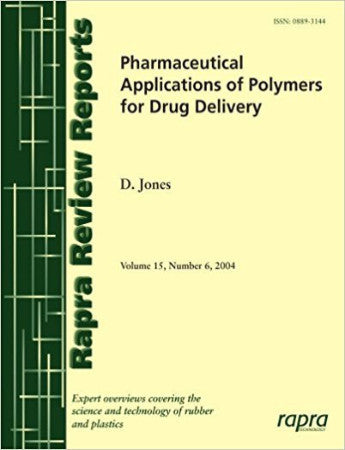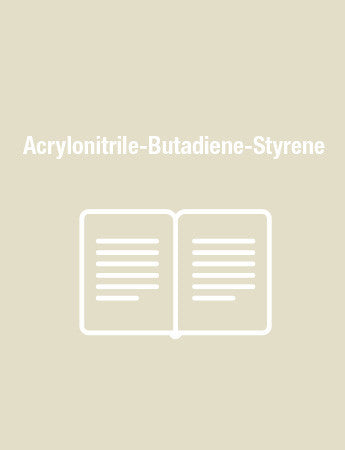Pharmaceutical Applications of Polymers for Drug Delivery
Polymers are becoming increasingly important in the field of drug delivery. The pharmaceutical applications of polymers range from their use as binders in tablets to viscosity and flow controlling agents in liquids, suspensions and emulsions. Polymers can be used as film coatings to disguise the unpleasant taste of a drug, to enhance drug stability and to modify drug release characteristics.
The review focuses on the use of pharmaceutical polymer for controlled drug delivery applications. Examples of pharmaceutical polymers and the principles of controlled drug delivery are outlined and applications of polymers for controlled drug delivery are described.
The field of controlled drug delivery is vast therefore this review aims to provide an overview of the applications of pharmaceutical polymers. The reader will be directed where necessary to appropriate textbooks and specialised reviews. Although polymers are used extensively as pharmaceutical packaging, this review is concerned with the use of polymers in the formulation of dosage forms.
This review will be of interest to anyone who has an interest in the pharmaceutical use of polymers, whether as a researcher or as a manufacturer of medical devices.
The review is accompanied by approximately 250 abstracts taken from papers and books in the Rapra Polymer Library database, to facilitate further reading on this subject. A subject and a company index are also included.
The review focuses on the use of pharmaceutical polymer for controlled drug delivery applications. Examples of pharmaceutical polymers and the principles of controlled drug delivery are outlined and applications of polymers for controlled drug delivery are described.
The field of controlled drug delivery is vast therefore this review aims to provide an overview of the applications of pharmaceutical polymers. The reader will be directed where necessary to appropriate textbooks and specialised reviews. Although polymers are used extensively as pharmaceutical packaging, this review is concerned with the use of polymers in the formulation of dosage forms.
This review will be of interest to anyone who has an interest in the pharmaceutical use of polymers, whether as a researcher or as a manufacturer of medical devices.
The review is accompanied by approximately 250 abstracts taken from papers and books in the Rapra Polymer Library database, to facilitate further reading on this subject. A subject and a company index are also included.
1. PHYSICOCHEMICAL PROPERTIES OF PHARMACEUTICAL POLYMERS
1.1 Introduction
1.2 Examples of Pharmaceutical Polymers
1.2.1 Vinyl Polymers
1.2.2 Cellulose Ethers
1.2.3 Polyesters
1.2.4 Silicones
1.2.5 Polysaccharides and Related Polymers
1.2.6 Miscellaneous Polymers
2. APPLICATIONS OF POLYMERS FOR THE FORMULATION OF CONVENTIONAL DOSAGE FORMS
2.1 Solid Dosage Forms
2.1.1 Tablets
2.1.2 Capsules
2.1.3 Film Coatings of Solid Dosage Forms
2.2 Disperse Systems
2.3 Gels
2.4 Transdermal Drug Delivery Systems (Patches)
3. APPLICATIONS OF POLYMERS FOR CONTROLLED DRUG DELIVERY
3.1 Introduction: Principles of Controlled Drug Delivery
3.2 Reservoir Systems
3.2.1 The Ocusert System
3.2.2 The Progestasert System
3.2.3 Reservoir Designed Transdermal Patches
3.3 Matrix Systems
3.4 Swelling Controlled Release Systems
3.5 Biodegradable Systems
3.6 Osmotically Controlled Drug Delivery Systems
3.7 Stimulus Responsive Drug Release
3.7.1 Ultrasound Responsive Drug Release
3.7.2 Temperature Responsive Drug Release
3.7.3 pH Responsive Drug Release
3.7.4 Electric Current Responsive Drug Release
3.8 Polymer-Drug Conjugates
4. GENERAL CONCLUSIONS
Additional References
Abbreviations and Acronyms
Abstracts from the Polymer Library Database
Subject Index
1.1 Introduction
1.2 Examples of Pharmaceutical Polymers
1.2.1 Vinyl Polymers
1.2.2 Cellulose Ethers
1.2.3 Polyesters
1.2.4 Silicones
1.2.5 Polysaccharides and Related Polymers
1.2.6 Miscellaneous Polymers
2. APPLICATIONS OF POLYMERS FOR THE FORMULATION OF CONVENTIONAL DOSAGE FORMS
2.1 Solid Dosage Forms
2.1.1 Tablets
2.1.2 Capsules
2.1.3 Film Coatings of Solid Dosage Forms
2.2 Disperse Systems
2.3 Gels
2.4 Transdermal Drug Delivery Systems (Patches)
3. APPLICATIONS OF POLYMERS FOR CONTROLLED DRUG DELIVERY
3.1 Introduction: Principles of Controlled Drug Delivery
3.2 Reservoir Systems
3.2.1 The Ocusert System
3.2.2 The Progestasert System
3.2.3 Reservoir Designed Transdermal Patches
3.3 Matrix Systems
3.4 Swelling Controlled Release Systems
3.5 Biodegradable Systems
3.6 Osmotically Controlled Drug Delivery Systems
3.7 Stimulus Responsive Drug Release
3.7.1 Ultrasound Responsive Drug Release
3.7.2 Temperature Responsive Drug Release
3.7.3 pH Responsive Drug Release
3.7.4 Electric Current Responsive Drug Release
3.8 Polymer-Drug Conjugates
4. GENERAL CONCLUSIONS
Additional References
Abbreviations and Acronyms
Abstracts from the Polymer Library Database
Subject Index
Professor David Jones Jones was appointed to the Chair in Biomaterial Science at Queen’s University in Belfast in 1999. His research interests are centred on the design, synthesis, formulation and characterisation of advanced medical devices and implantable/topical drug delivery systems. His work involves close liaison with the pharmaceutical and medical device industries and clinicians. More recently, his research has concerned novel silicones for medical device and drug delivery applications and additionally, research concerning medical device applications of novel biodegradable polymers from shell waste.




